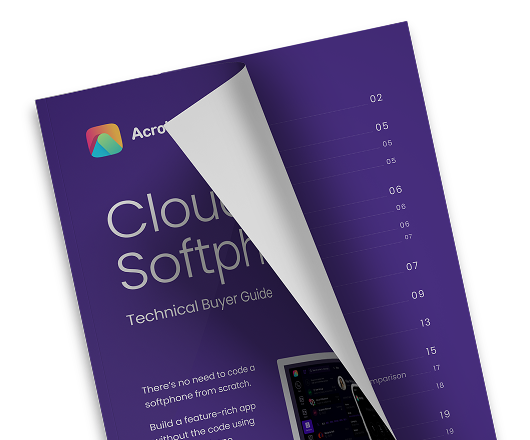
In our market, there are two types of players. On one side, you have proactive companies who adapt to OS changes before they are released. On the other hand, you have those who react to changes after they occur.
Acrobits falls into the former category. Since launching the first SIP app on the app store in 2009, we’ve been an industry leader in cloud communications. A recognized innovator whose ownership and management of our source code position us to support clients who prioritize business growth and peace of mind.
This article will delve into why, unlike one of our top competitors, we don’t build our software atop an open-source stack — starting with an explanation of the difference between open and closed.
Software generally falls into one of two categories:
It’s important to note that closed-source software can still be customized by entities other than the author. Many companies — Acrobits included — maintain and distribute Software Development Kits (SDKs) that allow software to be built atop their platform, enabling a great deal of customizability. There are also Application Programming Interfaces (APIs) to enable easy integration between different software platforms.
Many of you who are reading this piece have already experienced our Cloud Softphone app. You’ve experienced its efficiency and stability firsthand. You can expect the same from our SDK.
Developers in many sectors have had something of an ongoing love affair with open-source software, and it isn’t difficult to see why. Open-source deployments are flexible, affordable, and highly customizable. Collaboration and innovation are baked into their core, making them an incredibly attractive option for many.
At the same time, open-source isn’t perfect. While it may be well-suited for some deployments, it suffers from several huge drawbacks. Companies relying on open-source software stacks are often slower to react to changes in the market.

This lack of agility is unacceptable for our clients. Most of them work in highly competitive industries where the capacity to swiftly pivot and adapt in line with the competition is everything. They can’t afford to be held back by a vendor with a slow development lifecycle.
Quality control can also be an issue with open source deployments. Bugs that exist in open-source softphone applications may persist even with updates to the main stack. What’s more, open-source communication tools in particular often require a customer to manage and maintain the code themselves — something they may not be equipped to do.
This, in our experience, is one of the biggest drawbacks of solutions such as Linphone. You need to code everything yourself. Then you need to maintain that code.
We want to emphasize that open-source software isn’t bad, nor is it inferior to closed-source. It’s simply different. And for many companies, those differences are deal-breakers.
For most of our customers, the answer to both questions is no. Instead, they prefer to focus on a vendor who provides better services, allowing them to build their customer base rather than merely support it. That’s why Acrobits has always made a point of proactively equipping customers with everything the market has available.
We keep pace with every feature update, innovation, and OS release — with no coding required by the client. To that end, we’ve integrated our Cloud Softphone with Apple CallKit, Apple Local Push Integration, and Amazon’s Chime SDK. And that’s only the beginning.
We plan to continue ramping up. We plan to continue helping our clients grow and thrive, providing a flexible platform that grows and scales with your business. All the while, we’ll maintain the same transparent, streamlined pricing model — we cannot and will not align with any open-source pricing structures.
At the end of the day, by managing and maintaining our own source code, we’re better able to provide clients with a rich feature set, robustness, and quality. Our Cloud Softphone offers over 500 customization options, with 7-10 annual updates across all operating systems and a proactive roadmap.
Meanwhile, solutions such as CounterPath Stretto — built on an open-source stack — offers limited customization and provides manual updates on demand.
Closed-source might not always be the superior option compared to open-source. But in the case of Acrobits, the answer is clear. Cloud Softphone empowers your business with the communication infrastructure it needs to truly succeed.
Better yet, if you try it today, you can get 50% off your setup fees. Book a discovery call to learn more.

2024 was a big year for the telecom sector. This year’s shaping up to be even bigger. From artificial intelligence and regulatory challenges to Wi-Fi 7 and 6G, here are seven ways we expect the telecom industry to evolve in 2025. 1. AI Shapes Both Present and Future Unsurprisingly, artificial intelligence remains both the most […]

There’s no denying AI is making inroads in almost every part of business. But what happens when it comes to customer service? AI is transforming how businesses interact with their customers by automating repetitive tasks, analyzing data in real-time, and enabling personalized experiences at scale. From chatbots that resolve issues instantly to predictive algorithms that […]

Within an organization, teams and departments typically develop their own bonds and their own ways of communicating. But what happens when people from various business functions are brought together for a specific project? There are many advantages to cross-functional teams, which combine skills and resources to move projects forward and solve problems creatively. But the […]

TLDR: As MaX UC reaches it’s end-of-life, providers must decide between brand control, simplicity, or cost savings. Options include: Microsoft Teams for stability Cloud Softphone for flexibility and independence Or a reseller path for low-cost operations Each path comes with unique trade-offs in branding, customization, and long-term growth potential. Choose based on your priorities: fast […]